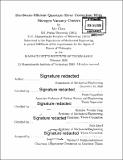Hardware-efficient quantum error correction with nitrogen-vacancy centers
Author(s)
Chen, Mo,Ph. D.Massachusetts Institute of Technology.
Download1155112029-MIT.pdf (16.42Mb)
Alternative title
Hardware-efficient QEC with NV centers
Other Contributors
Massachusetts Institute of Technology. Department of Mechanical Engineering.
Advisor
Paola Cappellaro.
Terms of use
Metadata
Show full item recordAbstract
Quantum technologies promise to revolutionize many fields, ranging from precise sensing to fast computation. The success of novel technologies based on quantum effects rests on engineering quantum systems robust to decoherence-the uncontrollable decay of quantum coherence, one of the very features that empowers quantum computation. To date, performance of quantum devices in the noisy intermediate-scale quantum (NISQ) era is still limited by decoherence. The long term solution is universal quantum computers that run on fault-tolerant quantum error corrected logical qubits which are immune to decoherence. However, the substantial overhead of qubits and quantum gates quantum error correction (QEC) imposes is thought to greatly limit its utility in NISQ devices. In this thesis, we address this challenge through a hardware-efficient approach-leveraging understanding of the quantum system towards more efficient and robust QEC protocols, which opens a potential avenue for useful QEC in near-term, pre-fault-tolerant devices. We are interested in the solid-state quantum register comprising the nitrogen-vacancy (NV) electronic spin and neighboring nitrogen and carbon nuclear spins. First, we developed techniques that provided us with precise knowledge of the system Hamiltonian and in turn high-fidelity and fast control. Next, we investigated and identified the decoherence mechanism of nuclear spins in the quantum register. The dominant noise turns out to be the thermal fluctuation of the NV electron. We demonstrated a dynamical decoupling approach to suppress the fluctuator noise and extended the nuclear spin coherence time. Furthermore, based on the precise knowledge of the system Hamiltonian and decoherence model, we customized a hardware-efficient QEC code for dephasing induced by a common fluctuator. This QEC code requires exponentially less overhead compared to the usual repetition code, and is robust to model imperfections. Finally, we developed experimental building blocks for near-term applications of the hardware-efficient QEC.
Description
Thesis: Ph. D., Massachusetts Institute of Technology, Department of Mechanical Engineering, 2020 Cataloged from PDF version of thesis. Includes bibliographical references (pages 159-178).
Date issued
2020Department
Massachusetts Institute of Technology. Department of Mechanical EngineeringPublisher
Massachusetts Institute of Technology
Keywords
Mechanical Engineering.